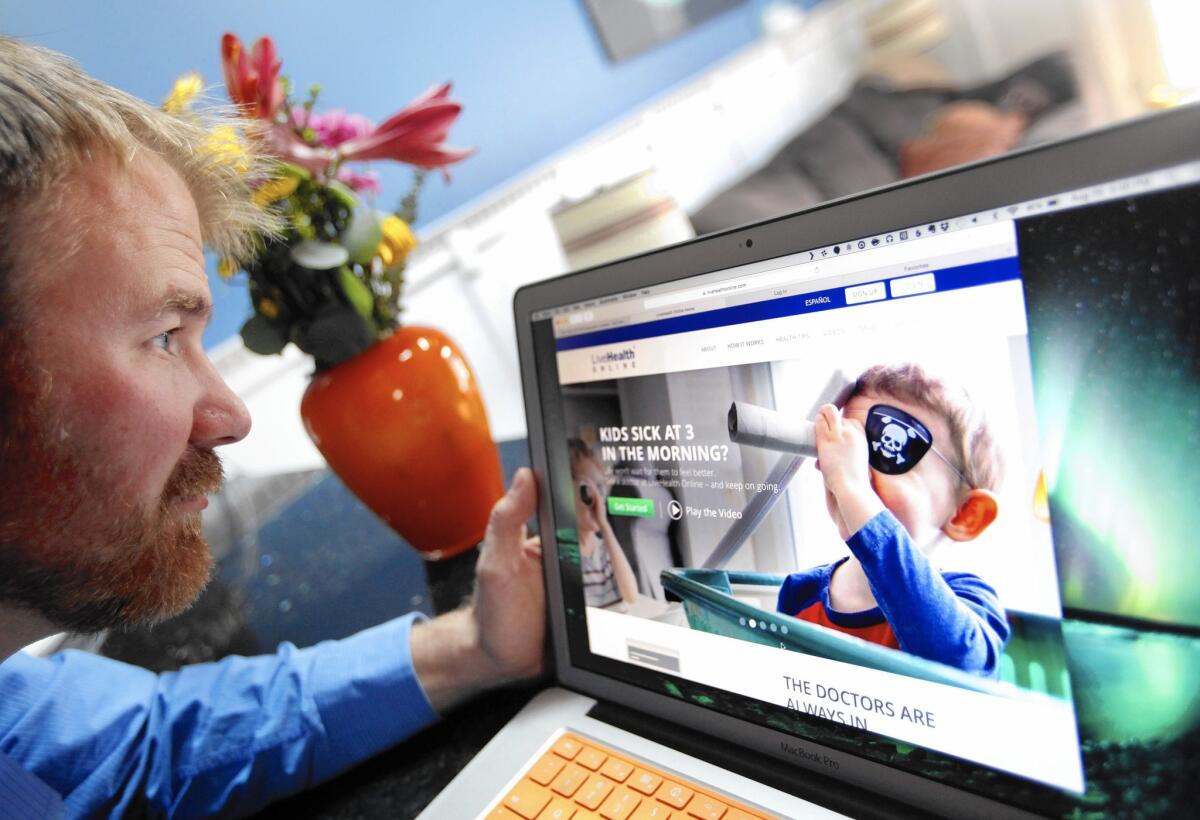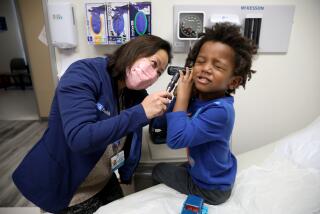The doctor is online: Remote video medical exams gain popularity

When Tom Essenpreis first signed up for his company’s Anthem Blue Cross health plan, he checked out its website and came across a service that enables him to visit with a doctor online 24 hours a day.
He downloaded it right away. “I immediately saw the utility of it,” said the 35-year-old aerospace engineer from Hawthorne.
The service came in handy one Saturday when his 2-year-old daughter had what he said was “goopy stuff clogging up the corner of her eye.”
Fairly certain that she had pinkeye, Essenpreis didn’t want to wait until Monday to see her pediatrician, and the prospect of sitting at an urgent-care provider with a toddler seemed like a bad idea.
So he turned to his computer. Within minutes, he said, a doctor was online and looking straight into his daughter’s eyes through the webcam. It was pinkeye. “She agreed with our diagnosis,” Essenpreis recalled.
Within an hour, he had a prescription for his daughter. The whole transaction took just minutes without Essenpreis’ ever leaving his home. He paid $49 for the session.
------------
FOR THE RECORD:
Healthcare Watch: In the Aug. 28 Business section, the Heathcare Watch column about the growing popularity of online medical consultations misspelled the name of one of the companies that provide such services. The company is Teladoc Inc., not Teledoc. —
------------
Remote video medical exams, also called telehealth or e-visits, are offered by a host of companies, including Teledoc Inc., American Well, MDLive Inc., Healthspot and Doctor on Demand. These consultations are growing quickly and increasingly included as a part of benefits packages offered by employers and insurers.
Typically, you’ll pay a fee of roughly $40 to $50 (sometimes less if it’s offered as part of your health benefits) for a 15-minute visit with a board-certified, state-licensed physician.
In its most recent annual survey, the National Business Group on Health in Washington found that 74% of large employers plan to offer telehealth services in 2016, up from about half in 2015.
A report last year by consulting firm Deloitte projected as many as 300 million e-visits within a few years, compared with just 800,000 the American Telemedicine Assn. expects in 2015.
“It’s being adopted more and more. We’re at the beginning of the curve,” said Adam Jackson, co-founder and chief executive of Doctor on Demand.
There are a number of reasons for this service’s rapid rise, experts say.
E-visits are everything traditional healthcare is not, said Brian Marcotte, CEO of the National Business Group on Health. “It’s convenient, it’s accessible after hours.... It’s efficient, and it’s efficient from a cost perspective as well,” he said.
As high-deductible health plans increasingly become the norm and consumers pay more for healthcare, they are demanding low-cost, convenient options.
It’s also a much faster way to access care. Today, the average national wait time to see a primary-care physician is about 20 days. By contrast, said Dr. Roy Schoenberg, president and CEO of Boston-based telehealth company American Well, an online visit “is incredibly quick. Within a minute or two, you can get in front of a physician.”
Another surprising benefit to online medical visits: “Patients like that the doctor is actually looking at them,” said Dr. Eric Topol, director of Scripps Translational Science Institute in La Jolla.
“When they go to a regular visit that they waited three weeks to get, the doctor is clicking keys on a keyboard,” he said. “Whoever would have thought that people would find the televisit more intimate and personal and humanizing than a physical visit?”
Still, consumers are largely unfamiliar with online medical visits. Experts cite several things to consider when using these services:
•Know when to log on. The most frequent use of remote sessions with a doctor today is for common ailments like respiratory illness, fever, ear and urinary tract infections, concerns about a child’s health, and skin or eye problems. Some vendors recently added online visits with a psychologist and lactation consultants for new mothers.
But the service isn’t for all maladies. “If you’re bleeding and it’s a bad gash and you need stitches, don’t start with us. If you have hypertension and diabetes and have chest pain, call 911,” Jackson said.
In the future, consumers can expect more advanced treatment available online, Topol said.
“You can do a lot of exams through a smartphone today, like ears and eyes and throat, lungs, heart. Right now, it’s just a flat video discussion. Pretty soon it’s going to morph into a much more sophisticated visit,” he said.
•Overcoming barriers. People still question whether doctors can do good healthcare without putting their stethoscope on the chest of a patient or palpitating their abdomen, Schoenberg said. “The answer is resoundingly yes. You can do it.”
And if you need to be seen in person, you’ll be referred.
•Still, concerns have surfaced. For example, a 2013 Rand Corp. study found that the rate of prescribing antibiotics for sinusitis and urinary tract infections was higher in an e-visit, and the likelihood that online doctors would order preventive care was lower.
“So there’s been some push-back from the medical community that maybe the quality isn’t optimal,” Topol said.
But Essenpreis was so pleased with his daughter’s treatment that he logged onto the telehealth service again, this time on his smartphone after leaving work with a sinus infection.
The visit took place in his car on the side of the road. Afterward he drove straight to the pharmacy for his prescription, Essenpreis said. “I didn’t even have to go home first.”
Twitter: @lisazamosky
Zamosky is the author of “Healthcare, Insurance, and You: The Savvy Consumer’s Guide.”
Hoy: Léa esta historia en español






